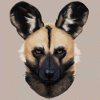
Design Overview of the
Cruiser Tank Mk. XI, Cavalier (A301)
by: G. Wolfe
IntroductionThe Cruiser Tank Mk. XI, Cavalier (A301) was the mainstay Nordenfeld light tank built for reconnaissance and screening purpose. The Cavalier featured many revolutionary features for the time of its introduction in 764, such as torsion bar suspension, a nine-cylinder W-Engine, and an entirely cast upper hull, at the time the largest single-piece casting ever produced for mass production vehicle. In total, over 19,000 Cavaliers of all variants were produced during its twelve years production period, most of which saw extensive service during the Border Crisis.
DevelopmentThe origin of the Cavalier light tank could be traced to the year 758, when the Border Guards - Paramilitary force of the Imperial Ministry of Internal Affairs - realized the needs for light protected vehicle to perform policing duties over the vast swath of lands bordering the United Terran Republics (UTR) in the north and the Union of Non-Aligned States (UNAS) to the south, as well as the Empire's many overseas holdings.
later that year, The Imperial Land Army (ILA) announced their interest to contribute to the program to split the cost of development and procurement of the new vehicle. Requirement was drawn up calling for a more capable design than had been originally envisioned by the Border Guards, allowing the vehicle to take up the role of reconnaissance-in-force for ILA's cavalry brigades in addition to its original policing duties
To support its new role, the vehicle was required to be able to negotiate rough and hilly terrain commonly found on the Empire's north and eastern border, withstand light anti-tank weapons of up to 30 mm caliber, while still being small and light enough to be easily transportable by trains and freighter aircrafts of the time.
Preliminary design was drawn up by the Newham arsenal in june of 760, showcasing a 15-ton light tank of a fairly conventional layout. The A300 prototype, as it was officially called, utilized sloped, multi-faceted welded RHA plates to compensate for reduced armour thickness required to comply with the weight restrictions. The development of high-resistance spring steel also allowed the designers to implement the torsion bar suspension on the vehicle, further reducing the weight of the vehicle and offering excellent off-road performance. The prototype was fitted with wooden mock-up turret as the armaments was yet to be decided, but provisions were made to fit either 30 mm or 47 mm cannon.
Trials at Newham proving ground yielded satisfactory result. Although the reliability of the W-engine left something to be desired, it was still acceptable enough for the design works to proceed. Instead, the Ordnance department placed more focus on the streamlining of its production process. The complex hull design of the A300 required too much time to construct and a large number of skilled welders must be mustered if Newham wanted to fulfill wartime needs - a precious workforce that were badly needed for Imperial Marine's shipbuilding programs.
Upon feedback from the Ordnance department, the A300 was redesigned to have a cast upper hull and a relatively simple, welded lower hull. The prototype was ready in January of 763 and was tested from February to April. Although ballistic test reveals that the cast armour performed 5% less in term of penetration resistance compared to RHA plates, it was still within the design requirement to withstand 30 mm anti-tank weapons. At the time, A300's cast hull must be produced and heat-treated by Nordstål Foundry in Invermoirh, then shipped to Newham for machining and final assembly. Modifications were required on Newham's vertical milling machines to precisely machine the turret ring and various fittings from the massive raw cast. With all equipment set up however, total production time was reduced significantly compared to the welded hull, without the needs of highly skilled workers.
The design was standardized as Cruiser Tank Mk. XI, Cavalier (A301) in 764, with first Cavalier Mk.I entering service later that year. Newham arsenal and Imperial Motors were appointed as the main contractor with cast components supplied by Nordstål. As the political climate heated in the years leading up to the outbreak of Border Crisis, Newham was directed to help set up production facilities across the Empire, including new casting plant at Torben Iron Works and Nordenfeld Mint. In total, 14 companies were contracted to build the Cavalier Light tank from 764 to 776, with total production figures across all variants exceeding 19,000 units.
DesignThough fast and highly manoeuvrable, the Cavaliers were lightly armed and armoured. Its cast hull had maximum thickness of 47 mm on the frontal arc, which was increased to 51 mm on later variants. Cast armour was choosen early in its inception to increase the speed of production and allowing more complex geometry to improve the hull's ballistic properties that would otherwise be very time consuming with welded armour. These advantages, however, came at the cost of lower armour toughness compared to welded RHA plates.
The cast turret had maximum thickness of 35 mm on both sides, with additional protection provided by 30 mm cast mantlet for a total thickness of 50 mm on the frontal arc. The turret is traversable by an electric traverse motor with a manual crank as a backup in case of a power failure. Main Armament of the early Cavaliers consisted of single G132 30 mm autocannons paired with a coaxial G24 6.35 mm rifle-calibre machine gun, similar to those of Gazelle II Armoured Cars. The need for heavier firepower to fulfil force screening role had its main armament replaced with low-pressure G5 75 mm L/26 gun-howitzer, firing HE and HESH ammunition with an effective range of 1,200 meters. An additional G30 15 mm medium-calibre machine gun could be fitted on external pintle mount for anti-air and anti-personnel purposes.
The weight of the tank was supported by newly-developed torsion bar suspension, which provided a very smooth ride and relatively larger roadwheel travel range compared to the more common Horstmann suspension used at the time. The running gear consisted of a pair of front-mounted drive sprocket, five pairs of rubberized roadwheel, two pair rubberized return rollers, and a pair of adjustable, all-metal idler wheel.
A rear-mounted 9-cylinder radial engine were initially considerd to reduce the total length of the hull while matching the power of a V8 engine. However, the central placement of the crankshaft required the propeller shaft to be mounted high in the hull; either interfering with the placement of the turret basket, or requiring a complex drop gearbox. In the end, the unique ACW690.57 9-cylinder, W-layout engine was chosen, utilizing three banks of three cylinders serving a low-mounted crankshaft. the propeller shaft drove a 5-speed manual syncromesh transmission fitted to the front of the hull.
The Cavalier had a crew of three, a driver sitting in the front part of the hull; a gunner on the right side of the turret; and a commander who also acts as the loader and sat across the gun breech beside the gunner. All crew had their own entry hatches, with the commader having a manually-rotatable cupola for increased situational awareness. To support its role as reconnaissance vehicle, each Cavalier were equipped with two-way HF/VHF radio set with a range of 15 km, Squadron commanders were supplied with an extra set tuned to batallion/regimental net.
A single, combat ready Cavalier light tank can be rigged for airdrop from a C-21 Cargomaster transport using Low Altitude Parachute Extraction System (LAPES). The crew does not ride in the tank during extraction, but parachutes from another plane to rendezvous with their vehicle upon landing.
Category All / All
Species Unspecified / Any
Size 2268 x 1624px
File Size 4.67 MB
A bit too big but i think not by much, it's not a big tank anyway, only about the size of stuart light tank
https://encrypted-tbn0.gstatic.com/.....w&usqp=CAU
https://encrypted-tbn0.gstatic.com/.....w&usqp=CAU

 FA+
FA+













Comments